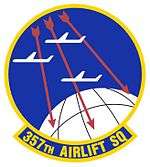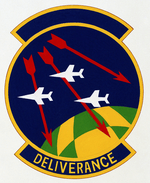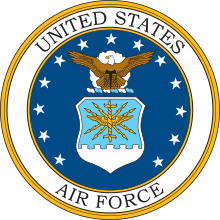357th Airlift Squadron
The 357th Airlift Squadron is a flying unit of the United States Air Force assigned to the Air Force Reserve Command and part of the 908th Airlift Wing at Maxwell Air Force Base, Alabama. It operates Lockheed C-130H Hercules aircraft providing global airlift.
357th Airlift Squadron
 | |
|---|---|
 Squadron C-130 Hercules landing at Maxwell AFB | |
| Active | 1942–1944; 1944–1946; 1952–present |
| Country | |
| Branch | |
| Role | Airlift |
| Part of | Air Force Reserve Command |
| Garrison/HQ | Maxwell Air Force Base |
| Engagements | Pacific Theater[1] |
| Decorations | Distinguished Unit Citation Air Force Outstanding Unit Award[1] |
| Insignia | |
| 357th Airlift Squadron emblem (approved 26 June 1986)[1] |  |
| 357th Tactical Airlift Squadron emblem (1986)[2] |  |
| 357th Bombardment Squadron emblem (approved 20 November 1945)[3] |  |
History
World War II
Constituted as 357 Bombardment Squadron (Heavy) on 28 January 1942. Activated on 1 June 1942 as a Consolidated B-24 Liberator Operational Training Unit, later becoming a Replacement Training Unit (RTU) for deployed combat units, assigned to II Bomber Command. Inactivated on 10 April 1944.[1]
Redesignated as a Boeing B-29 Superfortress very heavy bombardment Squadron under Second Air Force on 1 April 1944 at Dalhart Army Air Field, Texas. Initially equipped with Boeing B-17 Flying Fortresses for training, due to shortage of Superfortresses. Moved to McCook Army Air Field, Nebraska in August 1944 and equipped with B-29B limited production aircraft.[1]
After completion of training deployed to Central Pacific Area, assigned to XXI Bomber Command at Northwest Field (Guam) for operational missions. B-29Bs were standard production aircraft stripped of most defensive guns to increase speed and bomb load, The tail gun was aimed and fired automatically by the new AN/APG-15B radar fire control system that detected the approaching enemy plane and made all the necessary calculations.[3]
Mission of the squadron was the strategic bombardment of the Japanese Home Islands. Entered combat on 16 June 1945 with a bombing raid against an airfield on Moen. Flew first mission against the Japanese home islands on 26 June 1945 and afterwards operated principally against the enemy's petroleum industry. Flew primarily low-level, fast attacks at night using a mixture of high-explosive and incendary bombs to attack targets.[3]
Flew last combat mission on 15 August 1945, later flew in "show of Force" mission on 2 September 1945 over Tokyo Bay during formal Japanese Surrender. Inactivated on Guam 15 April 1946, personnel returned to the United States and aircraft sent to storage in Southwest United States. It was credited with participating in the Air Offensive, Japan; Eastern Mandates, and Western Pacific campaigns. The squadron received the Distinguished Unit Citation: Japan, 22–29 July 1945.[1]
Reserve operations
It trained for troop carrier missions from 1952 to 1967. The squadron airlifted troops and their equipment during the Cuban Missile Crisis, October–November 1962. Redesignated 357 Tactical Airlift Squadron on 1 Jul 1967; 357 Tactical Air Support Squadron on 25 Apr 1969; 357 Tactical Airlift Squadron on 15 Dec 1971 and Redesignated 357 Airlift Squadron on 1 Feb 1992.[1] During 1993, the squadron exchanged their C-7 for C-130 Hercules'.[1]
The squadron has flown numerous, worldwide airlift missions, including missions in the Gulf War and the Bosnian relief effort. It was awarded the Air Force Outstanding Unit Awards: 1 July 1972 – 15 March 1974; 1 January 1976 – 30 November 1977; 1 February 1980 – 31 January 1982; 1 September 1986 – 31 August 1988; 1 September 1991 – 31 August 1993.[1]
Lineage
- Constituted as the 357th Bombardment Squadron (Heavy) on 28 January 1942
- Activated on 1 June 1942
- Inactivated on 10 April 1944
- Redesignated 357th Bombardment Squadron, Very Heavy on 27 June 1944
- Activated on 7 July 1944
- Inactivated on 15 April 1946
- Redesignated 357th Troop Carrier Squadron, Medium on 26 May 1952
- Activated in the reserve on 14 June 1952
- Ordered to active duty on 28 October 1962
- Relieved from active duty on 28 November 1962
- Redesignated 357th Tactical Airlift Squadron on 1 July 1967
- Redesignated 357th Tactical Air Support Squadron on 25 April 1969
- Redesignated 357th Tactical Airlift Squadron on 15 December 1971
- Redesignated 357th Airlift Squadron on 1 February 1992[1]
Assignments
- 302d Bombardment Group, 1 June 1942 – 10 April 1944
- 331st Bombardment Group, 7 July 1944 – 15 April 1946
- 302d Troop Carrier Group, 14 June 1952
- 445th Troop Carrier Group, 16 November 1957
- 446th Troop Carrier Group, 25 March 1958
- 446th Troop Carrier Wing, 14 April 1959
- 302d Troop Carrier Wing, 8 May 1961
- 908th Troop Carrier Group (later 908 Tactical Airlift Group, 908 Tactical Air Support Group, 908th Tactical Airlift Group, 908 Airlift Group), 11 February 1963
- 908th Operations Group, 1 August 1992 – present[1]
Stations
|
|
Aircraft
- Consolidated B-24 Liberator (1942–1944)
- Boeing B-17 Flying Fortress (1944)
- Boeing B-29 Superfortress (1945–1946)
- Curtiss C-46 Commando (1952–1957)
- Fairchild C-119 Flying Boxcar (1956–1969)
- Cessna U-3 Blue Canoe (1969–1970)
- Cessna O-2 Skymaster (1970–1971)
- de Havilland Canada C-7 Caribou (1971–1983)
- Lockheed C-130 Hercules (1983 – present)[1]
References
Notes
- Russell, Edward T. (5 September 2008). "Factsheet 357 Airlift Squadron (USAFE)". Air Force Historical Research Agency. Retrieved 15 December 2017.
- "Approved insignia for: 357th Tactical Airlift Squadron". National Archives Catalog. 15 September 1986. Retrieved 15 December 2017.
- Maurer, Combat Squadrons, p. 444
Bibliography
![]()
- Cantwell, Gerald T. (1997). Citizen Airmen: a History of the Air Force Reserve, 1946–1994. Washington, D.C.: Air Force History and Museums Program. ISBN 0-16049-269-6. Retrieved 17 December 2016.
- Maurer, Maurer, ed. (1983) [1961]. Air Force Combat Units of World War II (PDF) (reprint ed.). Washington, DC: Office of Air Force History. ISBN 0-912799-02-1. LCCN 61060979. Retrieved 17 December 2016.
- Maurer, Maurer, ed. (1982) [1969]. Combat Squadrons of the Air Force, World War II (PDF) (reprint ed.). Washington, DC: Office of Air Force History. ISBN 0-405-12194-6. LCCN 70605402. OCLC 72556. Retrieved 17 December 2016.
- Ravenstein, Charles A. (1984). Air Force Combat Wings, Lineage & Honors Histories 1947–1977. Washington, DC: Office of Air Force History. ISBN 0-912799-12-9. Retrieved 17 December 2016.

.png)